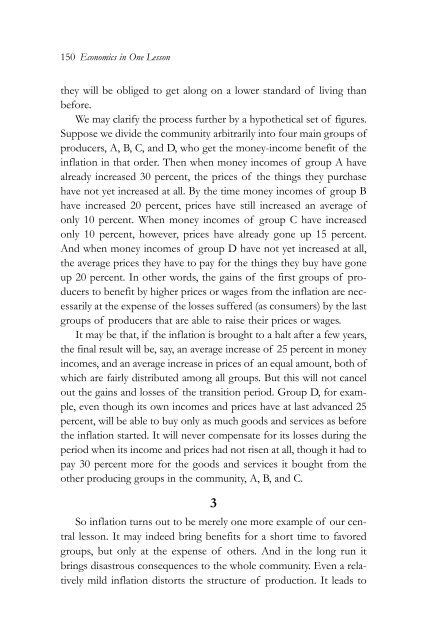1gDdM7w
1gDdM7w
1gDdM7w
- No tags were found...
You also want an ePaper? Increase the reach of your titles
YUMPU automatically turns print PDFs into web optimized ePapers that Google loves.
150 Economics in One Lessonthey will be obliged to get along on a lower standard of living thanbefore.We may clarify the process further by a hypothetical set of figures.Suppose we divide the community arbitrarily into four main groups ofproducers, A, B, C, and D, who get the money-income benefit of theinflation in that order. Then when money incomes of group A havealready increased 30 percent, the prices of the things they purchasehave not yet increased at all. By the time money incomes of group Bhave increased 20 percent, prices have still increased an average ofonly 10 percent. When money incomes of group C have increasedonly 10 percent, however, prices have already gone up 15 percent.And when money incomes of group D have not yet increased at all,the average prices they have to pay for the things they buy have goneup 20 percent. In other words, the gains of the first groups of producersto benefit by higher prices or wages from the inflation are necessarilyat the expense of the losses suffered (as consumers) by the lastgroups of producers that are able to raise their prices or wages.It may be that, if the inflation is brought to a halt after a few years,the final result will be, say, an average increase of 25 percent in moneyincomes, and an average increase in prices of an equal amount, both ofwhich are fairly distributed among all groups. But this will not cancelout the gains and losses of the transition period. Group D, for example,even though its own incomes and prices have at last advanced 25percent, will be able to buy only as much goods and services as beforethe inflation started. It will never compensate for its losses during theperiod when its income and prices had not risen at all, though it had topay 30 percent more for the goods and services it bought from theother producing groups in the community, A, B, and C.3So inflation turns out to be merely one more example of our centrallesson. It may indeed bring benefits for a short time to favoredgroups, but only at the expense of others. And in the long run itbrings disastrous consequences to the whole community. Even a relativelymild inflation distorts the structure of production. It leads to


